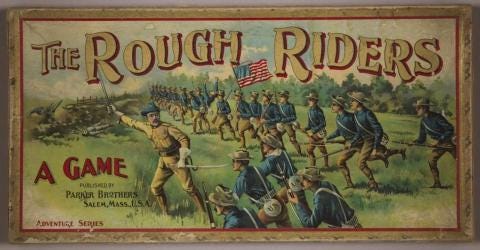Conspicuous Consumption: Friday, March 15, 2024
The Art of 1898, George Kennan, Latter-Day Nixon, Dorothea Lange, and More

“Conspicuous Consumption” is a bimonthly list of recommendations, drawn from my recent encounters with books, films, music, podcasts, and policy work, and whatever else catches my attention and needs to be digested and shared. Feel free to leave your own recommendations and thoughts in the comments.
Reading
Will Quinn, “‘The Russian Leopard Has Not Changed Its Spots,’” February 19, 2024, Engelsberg Ideas
A moderately shameless plug, I recently reviewed Gregory J. Wallance’s Into Siberia: George Kennan’s Epic Journey Through the Brutal, Frozen Heart of Russia (2023) for Engelsberg Ideas. Kennan, cousin of the famous diplomat of the same name, famously traveled across Eurasia in the late 19th century and went from being an unapologetic booster of Russia to one of its most severe critics after investigating its prison system. Kennan was a complex figure and autodidact with a willingness to follow the evidence wherever it led. This is essentially the opposite journey of a number of media figures in recent years, including former Fox News host Tucker Carlson.
Bret Devereaux, “The History Crisis is a National Security Problem,” March 10, 2024, Foreign Policy
Devereaux, a military historian based at UNC-Chapel Hill who specializes in ancient Rome but comments widely on contemporary national security and foreign policy issues, wrote this piece to capture the erosion of the historical profession in higher education as tenure-track positions and employment for history PhDs declines and the negative downstream impact on national security policy as civilian officials and military officers lose a crucial base of knowledge. It is a sobering piece, usefully read in tandem with an essay by Joe Stieb in War on the Rocks. My only critique is that the proposed remedy — plussing up National Endowment for the Humanities grants — is a bridge loan rather than a transformational approach to making the case for history as a discipline, winning new generations of undergraduate students to the field, and boosting its overall prospects. To do that, historians need to convince the public that both the knowledge and skills they impart are useful in a broad range of contexts — not just politically salient or academic.
Richard Nixon, Beyond Peace (1994)
Whether living in a neighborhood with a plethora of Little Free Libraries is a blessing or a curse is impossible to discern, but it does sometimes yield surprising books. This one, Nixon’s last before his death in the same year, is an intriguing take on the post-Cold War world. Although disgraced by Watergate, Nixon remained an avid analyst of foreign policy and world order whose observations are worth revisiting. A few passages are particularly interesting when it comes to post-Soviet Europe:
Two diametrically opposite possibilities loom along the Russian-Ukrainian border. They could develop a flourishing partnership such as the one between the United States and Canada, or they could find themselves behaving like India and Pakistan, two superarmed scorpions trapped in a bottle. Ukraine’s history of domination by Moscow would seem to make the unhappier prospect the more likely one… If Russia were to revert to authoritarianism, a strong Ukraine would be a vital deterrent to aggression."
Seeing
“1898: Imperial Visions and Revisions,” The National Portrait Gallery, Washington, DC
Although this recent exhibition of art and artifacts from the War of 1898 (aka the Spanish-American War) just closed, I revisited it via Princeton University Press’s handsome 1898: Visual Culture and U.S. Imperialism in the Caribbean and the Pacific (2023). Although little remembered by most Americans, 1898 was a watershed moment for the United States as a world power: ejecting Spain from Cuba and Puerto Rico, annexing Hawaii, and crossing the Pacific to capture the Philippines. The paintings range from Sargent’s portraits of William McKinley, Theodore Roosevelt, and Henry Cabot Lodge to striking photos of the leading anti-imperialists, such as W.E.B. Dubois, and national independence movement leaders Emilio Aguinaldo and Antonio Maceo. Most striking of all is William Cogswell’s portrait of Queen Lili‘uokalani, the deposed monarch of Hawaii. The runner-up might be the plethora of contemporaneous boardgames where players tried to blockade Cuba, lead the Rough Riders up San Juan Hill, and sink the Spanish fleet in Manila.
Dorothea Lange, “Seeing People,” The National Gallery of Art
Lange’s photographs of the Dust Bowl and Depression-era America are justly renowned, but this retrospective goes farther back and farther forward in her career: from her apprenticeship in the 1910s to her work documenting Japanese interment and forward to her travels in Ireland and Egypt. It is a striking exhibition that covers a broad swath of history, open through March 31, 2024.




